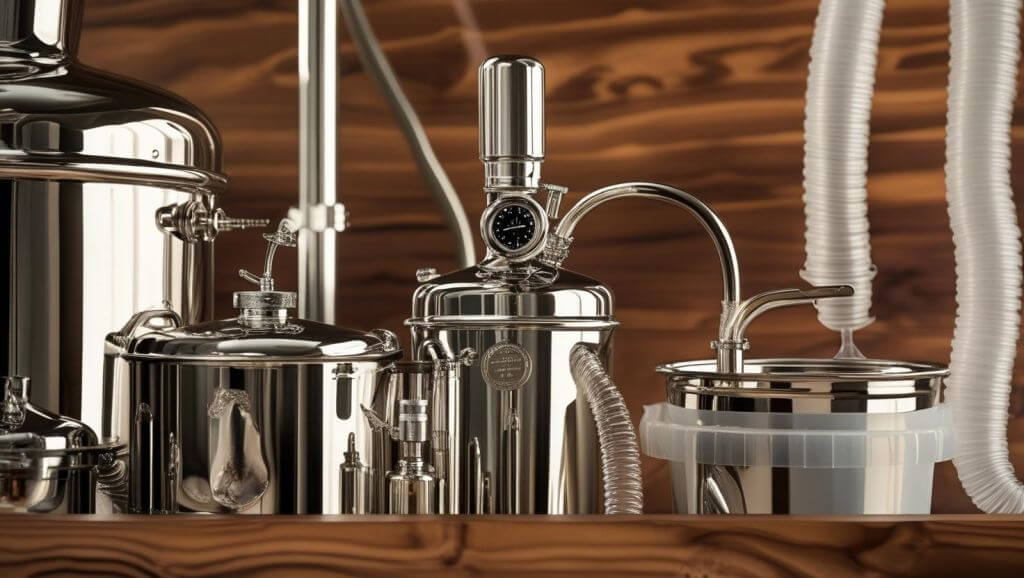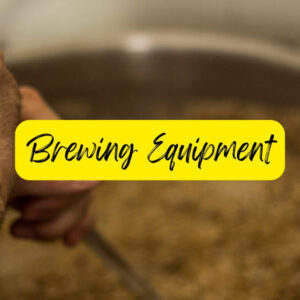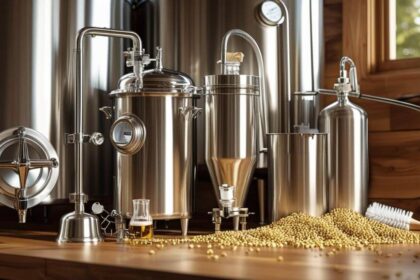Home brewing has surged in popularity, with more people discovering the satisfaction of creating their own craft beer at home. Whether you’re completely new to the hobby or looking to upgrade your current setup, understanding the essential home brewing equipment is crucial for success. This guide focuses on one of the most critical pieces of beer brewing gear: the fermenter with airlock system.
While there are many components that make up a complete brewing setup, the fermenter is where the magic truly happens. This is where your carefully prepared wort transforms into the beer you’ll eventually enjoy. Getting this part of your home brewing equipment right can make the difference between a successful batch and a disappointing one.
Understanding the Heart of Home Brewing: The Fermenter with Airlock
A fermenter with airlock is essentially a large, sealed container where the most important phase of beer making occurs. This crucial piece of beer brewing gear serves as the controlled environment where yeast converts the sugars in your wort into alcohol and carbon dioxide, creating the beer you’re after.
What Makes a Good Beer Fermenter
The best fermenters share several key characteristics. They need to be completely sanitizable, provide adequate space for fermentation, and allow you to monitor the process without compromising the sealed environment. Most home brewers choose between plastic bucket fermenters and glass carboy options, each with distinct advantages.
Plastic bucket fermenters are typically more affordable and easier to handle, especially for beginners. They’re lightweight, nearly unbreakable, and often come with pre-fitted lids designed to accommodate airlocks. Glass carboys, on the other hand, offer better long-term durability and don’t retain odors or scratches that could harbor bacteria.
The Critical Role of the Airlock System
The airlock system attached to your fermenter serves a vital function in the brewing process. This small but essential component allows carbon dioxide produced during fermentation to escape while preventing outside air and contaminants from entering your beer.
During active fermentation, yeast produces significant amounts of CO₂. Without a proper airlock system, pressure would build up in your fermenter, potentially causing the container to burst or the lid to pop off. The airlock prevents this while maintaining the anaerobic environment yeast needs to produce alcohol rather than vinegar.
There are several types of airlocks available for home brewing equipment. The most common are three-piece airlocks and S-shaped airlocks. Both work on the same principle: they create a water seal that allows gas to escape while preventing contamination from entering.
Choosing the Right Size and Material
When selecting your beer fermenter, size matters significantly. Most home brewing recipes are designed for 5-gallon batches, but you’ll want a fermenter with at least 6.5-gallon capacity to allow for proper headspace and vigorous fermentation activity.
Material choice affects both your brewing process and long-term satisfaction with your home brewing equipment. Food-grade plastic fermenters are excellent for beginners due to their affordability and ease of use. However, they can scratch over time, creating potential hiding spots for bacteria.
Glass carboys provide superior sanitation and longevity but require more careful handling. They’re heavier, more expensive, and can break if dropped. Many experienced brewers prefer glass for its non-reactive properties and the ability to see the fermentation process clearly.
Stainless steel fermenters represent the premium option in beer brewing gear. They offer the best of both worlds: durability, excellent sanitation properties, and professional appearance. However, they come with a significantly higher price tag that may not be justified for beginning brewers.
Setting Up Your Fermenter for Success
Proper setup of your fermenter and airlock system is crucial for successful home brewing. Start by thoroughly sanitizing every component that will contact your beer. Use a no-rinse sanitizer specifically designed for brewing to ensure you don’t introduce off-flavors or contamination.
Fill your airlock about halfway with sanitizer solution or clean water. Avoid overfilling, as vigorous fermentation can cause the liquid to bubble over into your beer. Insert the airlock into the rubber stopper or grommet in your fermenter lid, ensuring a tight seal.
Position your fermenter in a location with stable temperatures appropriate for your yeast strain. Most ale yeasts perform best between 65-75°F, while lager yeasts prefer cooler temperatures around 45-55°F. Avoid areas with temperature fluctuations or direct sunlight.
Monitoring and Maintaining Your Equipment
Once fermentation begins, you’ll notice bubbling activity in your airlock system. This indicates healthy yeast activity and proper CO₂ production. The frequency of bubbling will vary depending on temperature, yeast health, and the specific gravity of your wort.
Don’t be tempted to open your fermenter during primary fermentation. The sealed environment is critical for preventing contamination and oxidation. Trust your airlock system to do its job while you wait for fermentation to complete.
Regular maintenance of your home brewing equipment ensures consistent results and extends the life of your investment. Clean and sanitize your fermenter thoroughly after each use, and inspect it for any cracks, scratches, or other damage that could affect future batches.
Upgrading Your Fermenter Setup
As you gain experience with home brewing, you might consider upgrading your beer brewing gear. Conical fermenters allow for easier yeast harvesting and clearer beer by settling trub at the bottom. Temperature-controlled fermentation chambers provide precise control over fermentation conditions.
Some advanced home brewers invest in multiple fermenters, allowing them to have several batches in various stages of production. This approach maximizes your brewing output and lets you experiment with different recipes simultaneously.
Start Your Home Brewing Journey Today
The fermenter with airlock represents the heart of any home brewing equipment setup. By choosing quality beer brewing gear and understanding how these essential components work together, you’re setting yourself up for successful brewing adventures.
Remember that great beer starts with proper equipment and attention to detail. Your fermenter and airlock system will serve you well for countless batches if you invest in quality components and maintain them properly. Whether you’re drawn to the science of fermentation or simply love great beer, having the right home brewing equipment makes all the difference in your brewing success.









